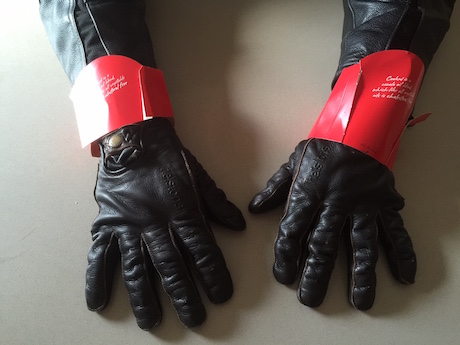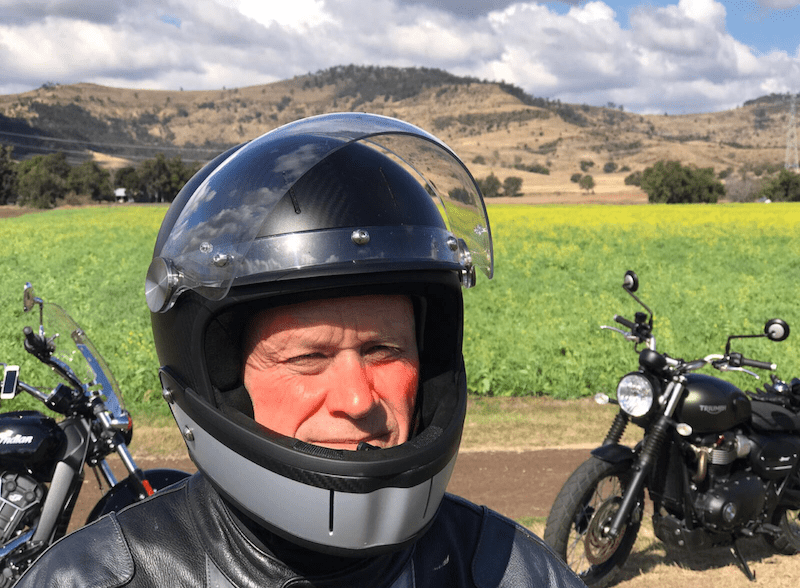Riders can suffer from dangerous sunburn on their faces – even in winter and even in full-face helmets – unless they take precautions.
It seems ridiculous to think about sunburn and skin cancer when your whole body is covered with protective riding gear.
However, the face is often overlooked.
Open-face helmets and even some of the modern retro full-face helmets with narrow chin bars, such as the Bell Bullitt and Veldt, expose much of your face.
That’s why many open-face users have beards and/or wear face masks or bandanas.
I use a neck sock with claimed UV protection to cover most of my face.
Bandanas
Bandanas serve multiple purposes, apart from preventing sunburn. They also stop visors from fogging up, they absorb sweat, and they can double as a headband, a neck coverer, or a face mask.
You can also use it to wipe the sweat from your forehead or face. Check out 4inbandana which is offering some high-quality and economical bandanas.

Even with a full-face helmet, the nose, cheeks and lips are often exposed for long times to the sun.
Most visors, even tinted visors, don’t have a very high UV protection factor or Sun Protection Factor (SPF) rating.
If your helmet makes a vague claim about UV protection, but doesn’t mention an SPF rating figure, you should be skeptical.
Riders on long trips can spend eight to 10 hours a day in the sun, yet a melanoma can begin to form in minutes – even before your skin starts to burn!
What is the SPF rating?
The Cancer Council points out that the SPF rating figure is the number of times the protection of having no sunscreen. Since your skin starts to burn in 10 minutes, an SPF15 visor will only protect you for 150 minutes or 2.5 hours.
Do the math on how long you will be riding and work out how much skin protection you really need. There are now SPF creams with SPF50+ ratings.
This is a serious subject and one close to our heart as a good friend, Emma Betts, recently passed away at the age of 25 from melanoma. She was a brave and devoted campaigner for melanoma awareness. You can read her Dear Melanoma blog here and you can donate to the Melanoma Institute Australia here.
Sunburn is also a winter problem
One of the problems with our awareness of skin cancer is that we tend to think of it only occurring in summer when it’s hot.
However the winter sun has just as many harmful UVA rays as in summer.
Riders should always carry a small tube of high SPF sunscreen in their jacket pocket, tank bag or panniers and ensure they re-apply during the day, even if using high SPF lotions.
Many lip balms not only shield you from UV rays, but also protect against painful wind burn.
Your sunglasses should also have a UV protection rating.
Other sunburn risks
Other areas of your body can also be exposed to the sun, apart from your face.
Do your sleeves meet your gloves when your arms are extended to the handlebars? Or is there a small gap at the wrist?
If so, slap some sunscreen on, or you could try this “hack” we quickly adapted on a long ride by using a Maccas chip bag to cover the gap.

Another place where the UV rays can get to your skin is the back of the neck, especially on sports bike riders who bend over.
Try a light neck sock to protect the skin. Even some of these have an SPF rating. As mentioned above, they are also good for covering much of your face. You can get them in thin and thick varieties for all seasons.
Riders also tend to stop along the way at lookouts, cafes, etc, where they expose more of their skin to the sun.
Remember when you stop to apply some sunscreen to the rest of your face, ears, hands and, if you’re like me, the top of your head!
However, on a hot day, be aware the sunscreen can dribble down into your eyes when you sweat.
In which case, pack a cap or foldable hat like Queenslander Chris Vermeulen’s famous towelling hat.




